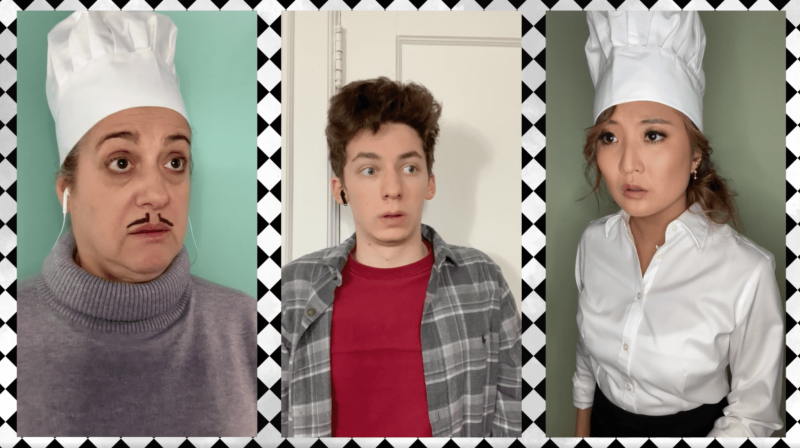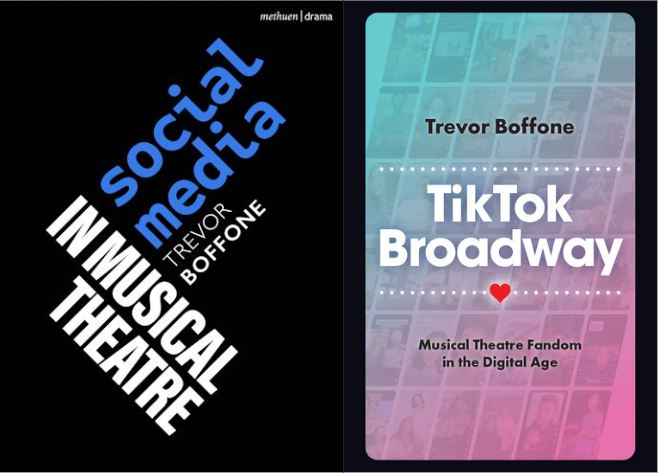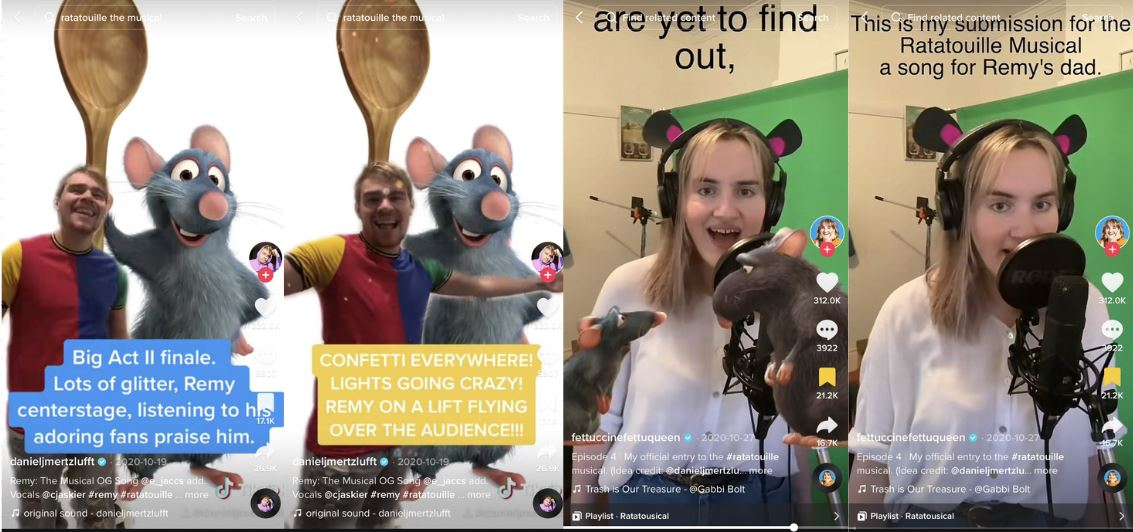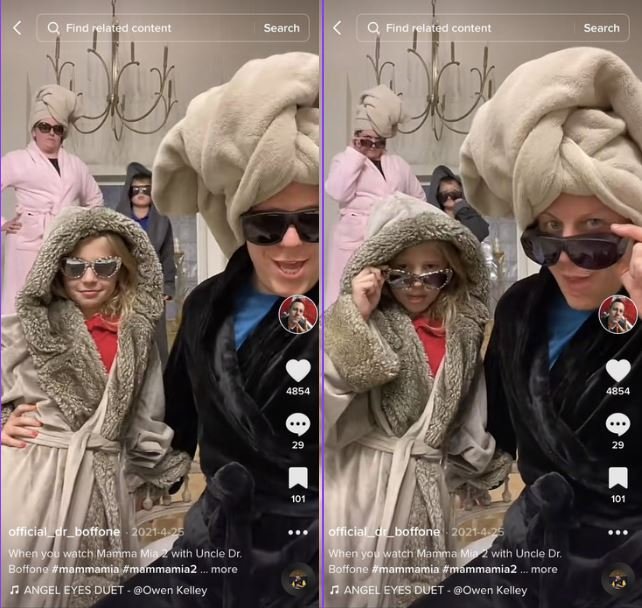TikTok Broadway: Towards a New (Digital) Canon of Musical Theatre
Trevor Boffone / University of Houston

TikTok loves musical theatre. Full stop. Since the platform became available in North America in August 2018, theatre fans have flocked to the most-downloaded social media network in the United States to engage with their favorite musicals. Musicals such as Beetlejuice, Heathers, and Six became ubiquitous with TikTok in 2019. A casual scroll on the TikTok For You Page (FYP) would give spectators an endless stream of content inspired by musicals, sometimes explicitly engaging with the musical (Beetlejuice fans cosplaying as they lip-synced songs from the score) and other times completely detached from the world of the musical (TikTokers doing the “Martha Dumptruck in the Flesh” trend from Heathers: The Musical’s act one song “Big Fun”) (Boffone 2021). These trends racked up millions of iterations, firmly cementing musical theatre into TikTok’s mainstream culture from day one.
Being the the musical theatre fanboy that I am, my FYP was filled with musical content as soon as I downloaded the app in late 2018. I had downloaded the app to create dancing videos and silly skits with my high school students, but TikTok knew what I wanted to see. It always knows. And being the TikTok scholar I am (and, TL;DR, being an absolute and utter nerd), this passion became not one, but two book projects: Social Media in Musical Theatre (Bloomsbury, 2023) and TikTok Broadway: Musical Theatre Fandom in the Digital Age (Oxford UP, 2024). But so what? What can musical theatre’s presence in the TikTok zeitgeist tell us about theatre fandom in the digital age?

TikTok’s musical theatre community has energized fan practices, leading to innovative digital fandom aesthetics and a democratized approach to fan community formation. In this democratized mode of creation, fans and audiences dictate trending content and, subsequently, canon formation. Fans have the agency to make shows popular (Six, Heathers), make them commercially successful (Beetlejuice), and develop new shows (Ratatouille: The TikTok Musical, Bridgerton: The Musical). The power lies in the fans, who have a far greater reach than on Tumblr, Facebook, Twitter, or Instagram. Just like TikTok has the capacity to dictate what music trends on the Billboard Hot 100, TikTok can also canonize musical theatre, something it achieves through virality and the repetitions that coincide with becoming a TikTok trend. As my work conveys, canonization on TikTok is at times a byproduct and at times an explicit goal. Whether derivative or purposeful, TikTok canonization transpires through democratization.

In addition to Beetlejuice, Heathers, and Six, musicals such as Hamilton, Newsies, Mamma Mia!, The Lightning Thief, Wicked, Frozen, and the collectively generated Ratatouille have all become integral parts of musical theatre TikTok (also called #TheatreTok). This cohort of musicals make up their own digital theatre community—TikTok Broadway. TikTok Broadway is a collection of trends on TikTok that riff off musical theatre, sometimes within the context of the show, but other times in a way devoid of the show’s original context. The app is home to a growing community of adept, young social media users who use the platform to engage with musical theatre fandom, at times even doing so unconsciously. As a democratized fan space, TikTok Broadway eschews several core tenets of commercial Broadway theatre, such as competition, rejections, and expensive tickets. In this digital world, musical theatre isn’t cost prohibitive. It’s accessible to everyone. There are no barriers.
TikTok Broadway privileges creativity, while helping fans find their fandoms and embrace their fan identities. Within this space, the archive of TikTok Broadway is a complex collection of musical theatre fandom and, as an extension, can “reveal some clear patterns of use, engagement, and utterances of feeling” (Wolf 2011: 223). As media studies scholar Andreas Schellewald proposes, TikTok videos, although ephemeral, “present themselves not as random and short-lived entertainment but as complex, cultural artifacts” (Schellewald 2021: 1439). Using this lens, we can begin to consider what musical theatre content on the platform reveals about fan identity formation and musical theatre engagement in the TikTok Age. This archive of cultural artifacts is expansive. Popular TikTok Broadway trends can facilitate hundreds of thousands of videos. Hashtags such as #MammaMia, #Wicked, #Hamilton, and #TheLionKing can lead to archives with hundreds of millions of video views (Mamma Mia! and Wicked) and even billions of views (Hamilton and The Lion King).

TikTok is a natural home for musical theatre fandom. TikTok Broadway facilitates what Amy Petersen Jensen refers to as a “participatory spectator,” who, “influenced by interactions with media forms, has learned to advance theatrical narratives beyond the threshold of the theatre space into their own private space” (Jensen 2007: 4). As Hillman-McCord notes, “Attending a live musical is now only a fraction of the experience a fan may have with a musical” (Hillman-McCord 2017: 3). Indeed, as Wolf proposes, “the Broadway musical truly lives beyond Broadway” (Wolf 2019: 5). TikTok Broadway expands musical theatre into a purely digital realm, which then spills into other, nondigital aspects of US popular culture.
Given the expansiveness of TikTok, musical theatre’s afterlife can seem endless. According to theatre scholar Alicia Corts, this mirrors the unique capabilities of virtual performance spaces: “we experience ways of performing that step outside the boundaries of the physical world, giving the illusion that virtual performance is unlimited” (Corts 2016: 113). TikTok is unlimited. Repetition and virality “give the illusion” that there is no end to TikTok Broadway. In fact, you can scroll with no end in sight. You are only limited by your phone’s battery and your attention span. As such, musical afterlives offer new possibilities to connect with musicals, something especially true for young Zoomer fans, who aren’t limited by analog in a way that previous generations were. By prioritizing musical theatre as an integral part of identity formation, young musical fans demonstrate how musical theatre can become canonized in a digital space. Although musicals such as Beetlejuice, The Lightning Thief, and Be More Chill might not have achieved critical success (when they premiered in New York City, at least), their digital afterlives have changed the narrative, cementing these shows in the musical theatre canon.
Musical theatre fan practices began to shift in the lead-up to the COVID-19 pandemic, cultural work that was being realized by Zoomers, or so-called members of Gen Z. By the time Broadway shut down in March 2020, musical fans were ready to migrate their fandoms to TikTok, creating democratized fan practices in the process. Although Zoomers had a significant role in this work—after all, TikTok is a largely Gen Z space—Millennials also flocked to TikTok. Zoomers and Millennials bolstered TikTok’s numbers, enabling it to flourish. So, too, did musical theatre fandom blossom on the platform. Hillman-McCord states, “As a highly popular art form, musical theatre has always acted as a mirror to society. Unsurprisingly, then, the form also reflects the ways we react to sweeping technological change” (Hillman-McCord 2017: 2). We are in the middle of a shift into the TikTok Age. As TikTok becomes more embedded in US popular culture, now is the time to understand its relationship to theatre at large.
Image Credits:- Screenshot of Ratatouille: The TikTok Musical featuring Mary Testa, Andrew Barth Feldman and Ashley Park (author’s screenshot).
- Covers of Social Media in Musical Theatre (Bloomsbury, 2023) and TikTok Broadway: Musical Theatre Fandom in the Digital Age (Oxford University Press, 2024).
- Screenshots from the crowd-sourced Ratatouille: The TikTok Musical (author’s screenshot).
- Author and family members doing the popular “Angel Eyes” trend from Mamma Mia! 2: Here We Go Again. April 25, 2021 (author’s screenshot).
Boffone, Trevor (2021). “From Heathers to Six: Stealth Musicals and the TikTok Broadway Archive.” Studies in Musical Theatre vol. 15, no. 3, pp. 175–89.
Corts, Alicia (2016). “(Un)limited: Virtual Performance Spaces and Digital Identity.” Theatre Symposium vol. 24, pp. 113–28.
Hillman-McCord, Jessica (2017). “Musical Theatre in the Digital Age.” In iBroadway: Musical Theatre in the Digital Age, edited by Jessica Hillman-McCord (Palgrave Macmillan), pp. 1–13.
Jensen, Amy Petersen (2007). Theatre in a Media Culture: Production, Performance and Perception since 1970 (McFarland).
Schellewald, Andreas (2021). “Communicative Forms on TikTok: Perspectives from Digital Ethnography.” International Journal of Communication vol. 15, pp. 1437–57.
Wolf, Stacy (2019). Beyond Broadway: The Pleasure and Promise of Musical Theatre across America (Oxford University Press).
Wolf, Stacy (2011). Changed for Good: A Feminist History of the Broadway Musical (Oxford University Press).